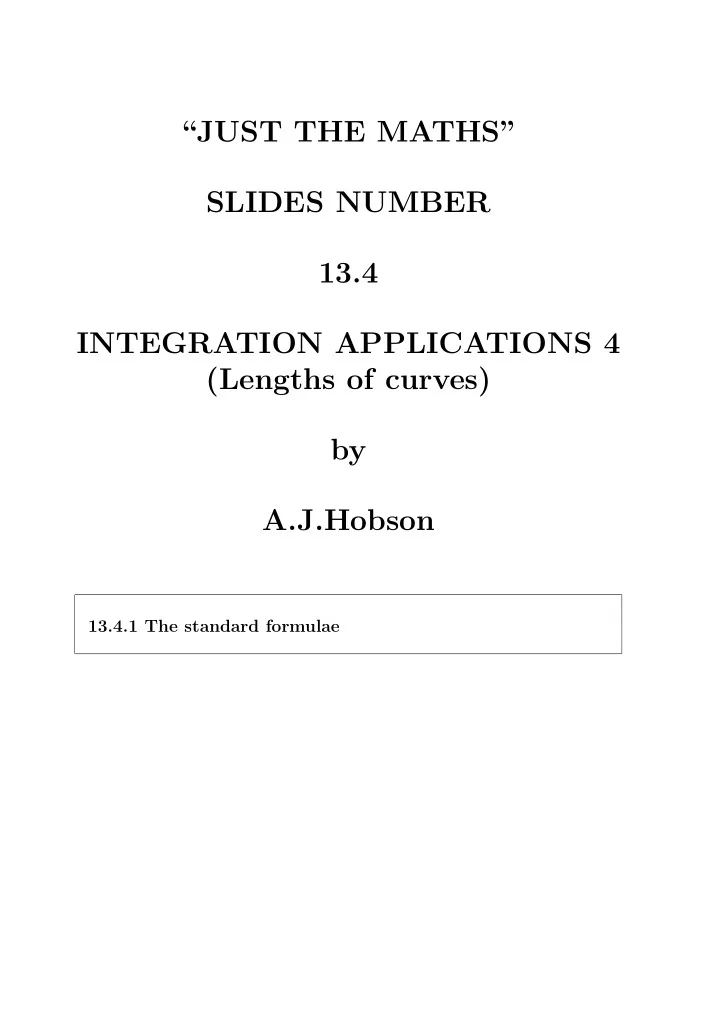

“JUST THE MATHS” SLIDES NUMBER 13.4 INTEGRATION APPLICATIONS 4 (Lengths of curves) by A.J.Hobson 13.4.1 The standard formulae
UNIT 13.4 - INTEGRATION APPLICATIONS 4 LENGTHS OF CURVES 13.4.1 THE STANDARD FORMULAE The problem is to calculate the length of the arc of the curve with equation y = f ( x ) , joining the two points, P and Q, on the curve, at which x = a and x = b . Q y ✻ δs δy r r P ✲ x O a δx b For two neighbouring points along the curve, the arc join- ing them may be considered, approximately, as a straight line segment. Let these neighbouring points be separated by distances of δx and δy , parallel to the x -axis and the y -axis respec- tively. 1
The length, δs , of arc between two neighbouring points is given, approximately, by � 2 � δy � ( δx ) 2 + ( δy ) 2 = � � � 1 + δs ≃ δx, � � δx using Pythagoras’s Theorem. The total length, s , of arc is given by � 2 � δy x = b � � s = lim � 1 + δx. � � � δx x = a δx → 0 That is, � 2 � d y � b � � s = � 1 + d x. � � a d x Notes: (i) If the curve is given parametrically by x = x ( t ) , y = y ( t ) , then d y d y d t d x = . d x d t 2
Hence, � 2 + � � 2 � � d y � � d x 2 � � d y � � d t d t � � 1 + = , � � d x d x d t provided d x d t is positive on the arc being considered. If d x d t is negative on the arc, then the above formula needs to be prefixed by a negative sign. Using integration by substitution, � � 2 2 � � d y d y . d x � b � t 2 � � � � � 1 + d x = � 1 + d t d t, � � � � a t 1 d x d x where t = t 1 when x = a and t = t 2 when x = b . We may conclude that � 2 2 � d x d y � t 2 � � s = ± + d t, � � t 1 � d t d t acccording as d x d t is positive or negative. 3
(ii) For an arc whose equation is x = g ( y ) , contained between y = c and y = d , we may reverse the roles of x and y , so that the length of the arc is given by � 2 � d x � d � � s = � 1 + d y. � � c � d y 4
EXAMPLES 1. A curve has equation 9 y 2 = 16 x 3 . Determine the length of the arc of the curve between 1 , 4 4 , 32 � � � � the point and the point . 3 3 Solution The equation of the curve can be written 3 y = 4 x 2 3 ; and so, d y 1 d x = 2 x 2 . Hence, √ � 4 s = 1 + 4 x d x 1 4 3 (1 + 4 x ) 2 = 6 1 3 3 = 17 6 − 5 2 2 6 ≃ 13 . 55 5
2. A curve is given parametrically by x = t 2 − 1 , y = t 3 + 1 . Determine the length of the arc of the curve between the point where t = 0 and the point where t = 1. Solution Since d x d t = 2 t and d y d t = 3 t 2 , we have √ � 1 4 t 2 + 6 t 4 d t s = 0 √ � 1 4 + 6 t 2 d t = 0 t 1 1 � 3 4 + 6 t 2 � = 2 18 0 = 1 3 ≃ 1 . 31 2 − 8 10 18 6
Recommend
More recommend